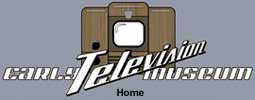Postwar Television An Inexpensive 7DP4 ReplacementDennis Choinski found a CRT that he thought would be a replacement for the 7DP4. He sent us one, and we tried it in our RCA 621TS. Here are the results: The tube is identical in size to the 7DP4, except that it is about an inch shorter. It was made for the U.S. Air Force, and when it arrives from the supplier it looks like this: Dennis had removed the gold covered coating and the rubber block over the anode connection on the sample he sent me. However, the gold coating is probably conductive, and could serve as aquadag. To make the tube look more authentic the gold could be spray painted black. Our tube has no coating, but works fine, since the 621 has a 500 pf HV capacitor. Electrically, the tube is similar, but has a low voltage focus grid. We removed the high voltage line from pin 6 of the tube and let it float. The picture was in perfect focus. Pin 6 could also be connected to B+ if the focus is better. This tube produces a bright, clear picture (it has a P4 phosphor), and makes an excellent replacement. The tube is the GL-4592.
|

